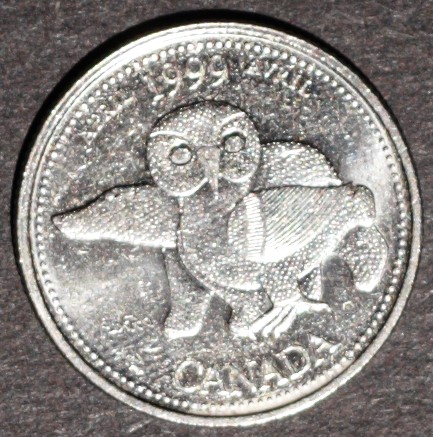Heads-or-Tales
This project is maintained by mslafrenie
Our Northern Heritage
Unprocessed Photographic View

While examining this coin consider the following:
- What elements of its design stand out most?
- How would you describe this coin’s design?
- What story is this coin narrating?
After exploring the unprocessed photographic view of this coin take a look at the RTI default view!
RTI Default View:
Instructions for use: 1) Click on the light bulb icon, 2) Drag cursor across image to move light position, 3) Select the question mark icon for further help.
Now that you have viewed both the unprocessed image and the RTI model, take a look at the background information for this coin and my close reading of the myth identified as part of its banal nationalistic power:
Designer: Kenojuak Ashevak
Release Date: April 1999
Description: This “coin is a tribute to contemporary Canadian Inuit art.”
Myth(s) Resisted: Myth of the Wilderness, Myth of the North
My Close Reading:
Excerpt from RTI Investigation:
“In seeing and acknowledging the details of Ashevak’s work up close, viewers are encouraged to ask questions about the generative process, as well as the compositional aesthetic. What tools did she use to create these textures? How did she superimpose the forms of both animals? Why are these animals superimposed? What is revealed or rather gained through RTI analysis of Our Northern Heritage is the physicality and style of the design. This close reading and the nuances of Ashevak’s design parallel the ways in which this coin can be understood as resisting hegemonic depictions and myths of northern-ness in Canada. Her design is filled with texture, depth and imbued with Inuit knowledge such as wisdom, power, and kindness. When read together, these components allude to the complexities of Inuit lifestyles, traditions, and stories. Just as RTI brings us closer to understanding the materiality of this coin, so too does this design bring us closer to understanding and potentially de-stabilizing narratives of the North as simple, monolithic, unimportant, and inherently Canadian.”
Excerpt from Investigation of Myth:
“Since the mid-twentieth century, Inuit art has been understood by many Canadians as a unique and “accurate” representation of Inuit peoples as well as synonymous with a Canadian art form and identity. Regulated paternally by the Government of Canada and various departments from as early as the 1920s, Indigenous art, particularly Inuit art, has become popular domestically and internationally (i.e. souvenirs at tourist sites, official gifts to foreign dignitaries, the Canadian pavilion at Expo ‘67, and even the Vancouver 2010 Olympics).[79] This relationship can be traced back to shifting perspectives of Canadian identity during the mid-twentieth century. The struggle to identify as a nation independent from Britain and the United States is what drove much of Canada’s identity struggles in the twentieth century and is precisely why Inuit art appeals to many. Pupchek links this desire for community stability with the positioning of “Inuit art as an appropriate rhetorical resource for national identity,” which also affirmed it as a desirable method of national expression.[80] Art can then be understood as a way of creating and stabilizing the nation, thus as Inuit art comes to represent Inuit communities and is considered “authentic” to their lifestyle, traditions, and experiences, it was also co-opted as an “original” art form springing up from within Canadian boundaries.”
NOTES:
- [79] Leanne S. Pupchek, “True North: Inuit Art and the Canadian Imagination,” American Review of Canadian Studies 31, no. 1–2 (June 2001): 201-02; Nelson H. H. Graburn, “Authentic Inuit Art: Creation and Exclusion in the Canadian North,” Journal of Material Culture 9, no. 2 (July 2004): 144. “Inuit arts and crafts would be rendering a service to the nation by replacing the inauthentic souvenirs from other countries with authentically Canadian examples. This attempt to call upon the Inuit and their arts as metonyms of everything truly Canadian is repeated later in history […]”; Colette St-Onge, “Symbols of Authenticity: Challenging the Static Imposition of Minority Identities Through the Case Study of Contemporary Inuit Art,” (master’s thesis, University of Ottawa, 2012), 12.
- [80] Pupchek, “True North,” 205.